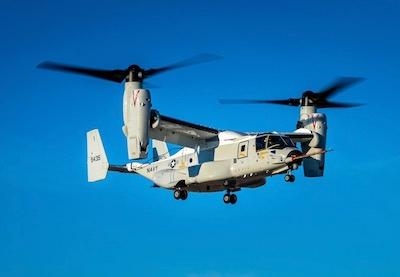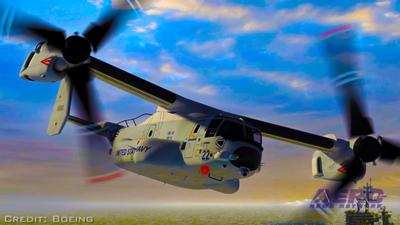The CMV-22B Will Undergo Fleet Delivery In 2021
The Navy accepted the first CMV-22B Osprey this week, with fleet delivery to follow in 2021. The government-industry team celebrated the acceptance milestone during a reveal ceremony Feb. 7 at Bell’s Assembly Center in Amarillo, Tx. The delivery milestone comes after only four years of design, production and first flight.

“There is nothing more important than delivering capabilities to the Fleet with speed,” said James F. Geurts, assistant secretary of the Navy for research, development and acquisition. “I am proud how the program and industry team have leveraged non-traditional approaches such as using existing MV-22 testing data to shrink the time in the CMV-22 acquisition cycle. The speed to get to this delivery milestone is a testament to the rigor and energy they put into the acquisition strategy and risk reduction initiatives during test and design.”
The CMV-22B is a variant of the MV-22B and is the replacement for the C-2A Greyhound for the Carrier Onboard Delivery (COD) mission. The aircraft will be used to transport personnel, mail, supplies and high-priority cargo from shore bases to aircraft carriers at sea.
To meet the operational needs of the Navy, the test program proactively sought risk reduction opportunities leveraging the MV-22B for shipboard and high gross weight testing. In addition, the integrated test team is focused on delta testing, differences between the MV-22B and CMV-22B, shortening the overall test program. Finally, the Navy stood up a Naval Aviation Training Support Group (NATSG) at MCAS New River, enabling the CMV-22 to utilize the infrastructure at Marine Medium Tiltrotor Training Squadron (VMMT) 204. These, combined with other “speed to the fleet” initiatives, allow for initial deployment just 18 months from first flight.

The first of two CMV-22B aircraft intended for developmental test recently ferried to Naval Air Station Patuxent River. The aircraft is assigned to Air Test and Evaluation Squadron (HX) 21, the squadron leading the developmental test efforts for the program. The first operational squadron, Fleet Logistics Multi-Mission Squadron (VRM) 30, is scheduled to receive the aircraft this summer.
“Accepting the first aircraft and ferrying it to Patuxent River to continue developmental testing is a critical step forward for the program,” said U.S. Marine Corps Col. Matthew Kelly, program manager for the V-22 Joint Program Office (PMA-275). “Our government-industry team can be proud of this milestone as we prepare to put the CMV-22B through testing which will ensure it is ready to support the Navy anywhere around the world.”
HX-21 and Bell conducted the aircraft’s first flight in December prior to transiting cross-country to continue development test. The integrated test team, which includes pilots, aircrew, engineers and maintainers from HX-21, Naval Air Warfare Center Aircraft Division, Boeing and Bell, will conduct developmental test over the next year.
“The CMV-22B will enable the Navy to supply the carrier strike groups with what they need to project sea power, anytime, anyplace,” said Kelly.
The CMV-22B will be capable of transporting up to 6,000 pounds of cargo and/or personnel over a 1,150 nautical mile range. This expanded range is due to the addition of two new 60 gallon tanks installed in the wing for an additional 120 gallons of fuel and the forward sponson tanks were redesigned for additional capacity.
The CMV-22B variant has a beyond line-of-sight high frequency radio, a public address system for passengers, and an improved lighting system for cargo loading. The aircraft will also be capable of internally transporting the F-35C Lightning II engine power module.
PMA-275 manages the cradle to grave procurement, development, support, fielding and disposal of the tiltrotor program systems for the U.S. Marine Corps, U.S. Air Force's Special Operations Forces and U.S. Navy.
 Unfortunate... ANN/SportPlane Resource Guide Adds To Cautionary Advisories
Unfortunate... ANN/SportPlane Resource Guide Adds To Cautionary Advisories ANN FAQ: Turn On Post Notifications
ANN FAQ: Turn On Post Notifications ANN's Daily Aero-Term (04.29.24): Visual Approach Slope Indicator (VASI)
ANN's Daily Aero-Term (04.29.24): Visual Approach Slope Indicator (VASI) ANN's Daily Aero-Term (04.28.24): Airport Marking Aids
ANN's Daily Aero-Term (04.28.24): Airport Marking Aids ANN's Daily Aero-Linx (04.28.24)
ANN's Daily Aero-Linx (04.28.24)




